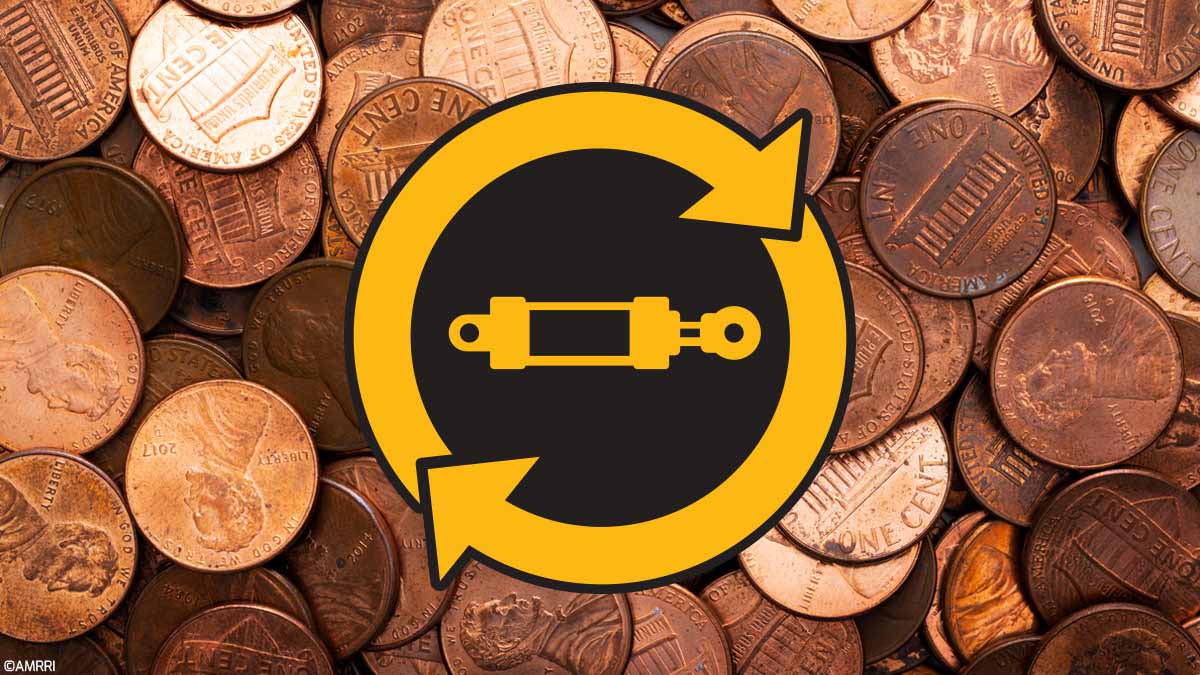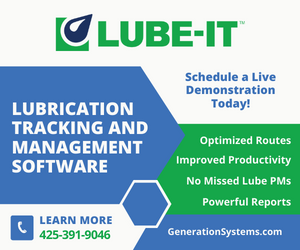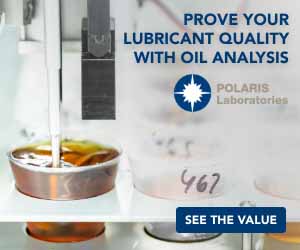Despite their complexity, hydraulic systems are forgiving in nature. In most cases, they can perform well for a long time before any significant or catastrophic failure occurs.
Unfortunately, this “creep to failure” quality can promote apathy in production and maintenance attitudes toward failure prevention, efficiency optimization, and service-life management of these workhorse systems.
The most critical component in any hydraulic system is, unequivocally, its hydraulic-fluid medium. Hydraulic fluid is an engineered component designed to perform three major tasks simultaneously:
- Act as a solid to transfer and amplify power.
- Lubricate a system’s moving parts.
- Absorb and dissipate frictional heat buildup within the system.
If the hydraulic system is to perform efficiently, the hydraulic fluid must be kept scrupulously clean and contamination-free. Knowing and acting on this simple requirement provides the maintenance planner with an easy, laser-focused strategy to manage and prevent most hydraulic system failures for literally pennies a day.
Hydraulic-fluid contamination can be present in three forms, i.e., as a solid particle, water, or air, which can seriously affect the fluid’s effectiveness and damage the components it serves.
Maintaining hydraulic fluid in an optimum condition requires a preventive strategy focused on measuring, controlling, and preventing the introduction of all three forms of contamination.
Solids Contamination
Hydraulic systems are not “dirt” tolerant. Cylinders and spool-valve assemblies are designed with precise operating tolerances that can be closer than .0002″, or 5 microns in size (the size of a human red blood cell).
For comparison, a human hair is approximately .0035″ in diameter or 80 microns. Most solids manifest as grit or dirt of 100 microns or more in size that, if allowed to enter a hydraulic system, will damage machined surfaces and hydraulic seals.
In a close-tolerance environment, solid particles set up in a three-body abrasion state that will easily score mated machined surfaces, creating rapid bearing and component surface wear. This leads to undesirable fluid bypass, causing reduced hydraulic operating efficiency.
Solid contaminants can induce a variety of problems. They include valve stiction, in which valves can become “sticky” and inefficient due to static friction; increased fluid viscosity that results in sluggish operation (due to excess fluid thickness); and unwanted fluid leakage, where “nicked” and scored cylinder seals and wipe surfaces allow the contaminant to be pushed, or “weep,” past the seal.
If the equipment is new or freshly rebuilt, all hoses, lines, and fittings must be cleaned internally. This is best accomplished using a compressed-air-projectile cleaning tool/system that shoots cleaning-wad material through the hoses and fittings to remove all dirt and swarf before connecting all lines and performing an initial system flush.
Once cleaning and flushing are complete, the system filters can be changed, and the reservoir and system filled with correct-viscosity hydraulic oil are ready for service.
Solid contamination can also find its way into new hydraulic fluid before delivery by the supplier or manufacturer, especially if bulk transferred with dirty transfer hoses and equipment. When receiving new oil—especially bulk oil—always perform an oil-analysis test to detect solids and water contamination.
New oil for use in high-pressure hydraulic systems should test, at least, at an ISO cleanliness level of 16/14/11 or better. To prevent receipt of unacceptable hydraulic fluid, set up a cleanliness contract with your oil supplier based on a contracted minimum cleanliness level. The supplier would then be bound to provide proof of cleanliness upon delivery.
Other preventable primary sources of maintenance-introduced solids contamination include:
- improperly stored oil (loose or open lids, incorrect container orientation, etc.)
- non-dedicated or dirty transfer equipment is used to transfer the oil into the equipment reservoir
- reuse of dirty “leaked” oil
- “open to air” reservoir due to missing fill-port or missing reservoir breather
- lack of filter maintenance, causing dirty oil to bypass into the system
- incorrect filter rating (a 100-micron filter rating provides zero system protection)
- poor housekeeping practices (cleanliness is godliness when handling lubricants and hydraulic fluids).
Water Contamination
Hydraulic fluid is naturally hygroscopic (water-retentive) and can entrain moisture until its saturation point. Most hydraulic fluids’ saturation point is reached around 300 ppm, or at a 0.04% concentration level.
Water is a universal contaminant that can deplete vital oil additives and react with them to create corrosive acids that can attack system components.
In addition, water can reduce lubricant film strength and its ability to release air, thus increasing the chances of wear, corrosion, and cavitation (see “Air Contamination” section below). In high-heat applications, water can also “boil off “and create significant inefficiency in the hydraulic-power transfer motion.
Typical preventable water contamination sources include:
- incorrect outdoor lubricant storage hot-cold cycle condensation
- “open to air” reservoir allowing ingression of wash down and process water.
Water can be present (and visually detected) in a free state (separated from the oil in an unstable form) and an emulsified state (in a stable form, the fluid appears cloudy).
It must be dealt with by using a polymeric-style filter media designed to absorb the water as it passes through the filter, through vacuum distillation to “boil off “the oil, and/or through dehumidification of the air in the reservoir headspace with the use of desiccant breathers.
Air Contamination
Air contamination causes problems when entrained in the fluid or oil. In this form, air bubbles less than one millimeter in diameter are dispersed throughout the fluid, reducing fluid viscosity and resulting in a lack of full film strength, causing premature component wear.
Entrained air can also reduce oil’s bulk modulus, causing a lack of efficiency and control due to the sponginess of the oil condition and increasing the heat load, resulting in fluid deterioration and system erosion or cavitation wear.
As for air bubbles, those over one millimeter can create foam, quickly depleting any hydraulic fluid antifoam additive and causing the fluid to oxidize.
Typical preventable-air-contamination causes include:
- over/under-filled lubricant reservoir(s)
- clogged inlet/suction filters
- clogged reservoir breather
- restricted inlet line
- loosely clamped inlet lines
- pump-shaft seal failure.
Fortunately, contamination problems are easily preventable and inexpensive to implement.
The following recommendations can be used as a checklist or starting point for an improved PM approach to hydraulic system preventive maintenance.
- Implement a fluid cleanliness standard.
- Store all lubricants in a cool, dry place and practice FIFO (First In-First Out) stock rotation.
- Practice good housekeeping and ensure reservoirs are kept clean of all dirt and debris.
- Cap all hydraulic hoses and manifolds during handling and maintenance.
- Wad-clean all lines before initial system startup.
- Flush all lube systems before startup and change oil and filter(s).
- Use a dedicated filter cart (one for each hydraulic fluid type) with quick-connect fittings to transfer and clean hydraulic fluid before it enters a reservoir.
- Install external sight gauges marked with high- and low-fluid markers on reservoirs to check for water contamination and correct fluid levels (leakage detection).
- Have the machine operator regularly check for system reservoir levels and leaks.
- Repair all system leaks as soon as they are discovered.
- Use polymeric oil filters and desiccant reservoir-style air breathers.
- Specify cylinder-rod wipers and replace all worn actuator seals.
- Regularly perform oil-analysis testing in hydraulic fluids for cleanliness and additive efficacy.
Bottom Line
Remember the hardworking hydraulic systems in your plant. They are the lifeblood of many manufacturing operations. Their effectiveness is not just a financial concern; it’s also a safety concern. With basic care, common sense, and little expense, you can ensure these systems are efficient, reliable, and long-lived.
Previously published in The RAM Review.









